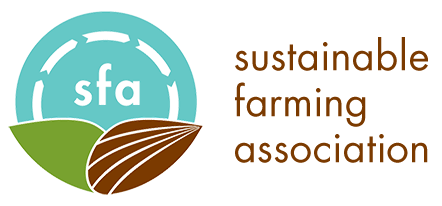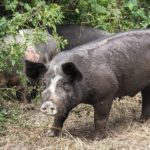Pastured Pork Fact Sheet
Click here to download a printable version of this fact sheet.
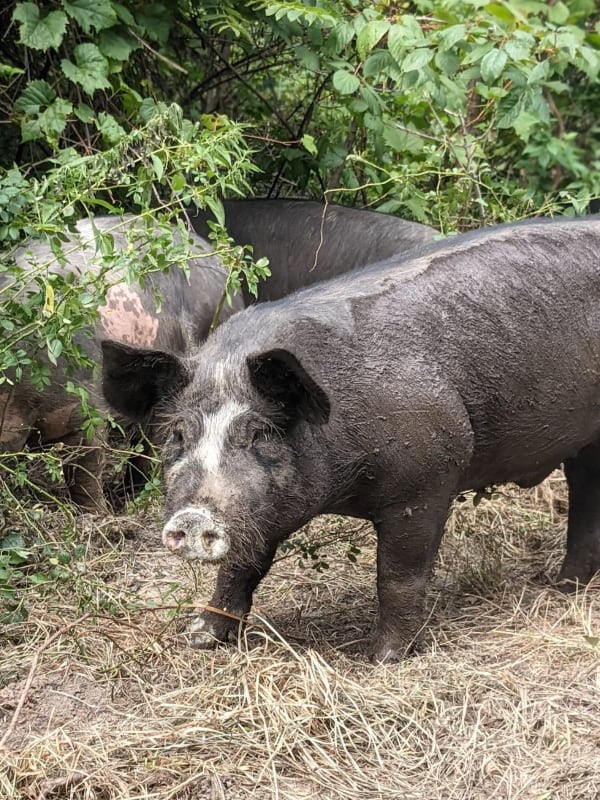
Why Consider Pigs?
- Worldwide, pork is the most widely consumed meat. Pork is a highly efficient and cost-effective protein to produce.
- When compared with livestock such as cattle, pigs have a much shorter finishing time which allows your initial investment to be paid back much sooner.
- Pigs can effectively utilize what many consider to be waste products (brewers grains, orchard/cider mill waste, whey/milk products, grain screenings, etc.) and turn them into a nutrient-dense protein and a potential profit center for an operation.
- Pigs can be used as a land management tool, converting brushy or wooded areas into silvopasture or open fields. Alternatively, pigs can scavenge dropped grain on crop fields after harvest.
- Pigs can be easily trained to electric fence, which makes initial investment in fencing minimal and relatively inexpensive.
- Use hogs to disrupt pest cycles in other livestock production systems.
- With experience, pigs are easy to fence and manage on the land.
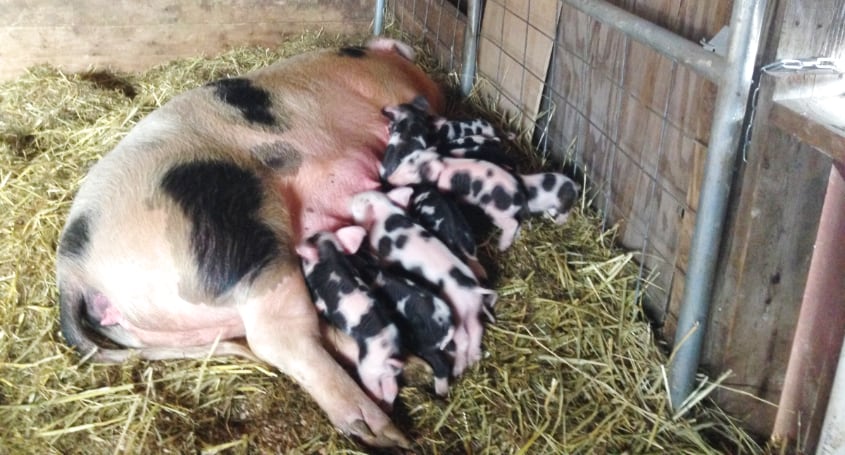
Farrowing. This and all other photos below taken by Jonathan Kilpatrick.
Pig Facts
- A sow’s gestation is 114 days or, as some like to say, three months, three weeks, and three days.
- Giving birth to piglets is called farrowing.
- Female pigs who have farrowed are called sows, while a young female pig who has not given birth is called a gilt. Mature, intact males are called boars. A barrow is a castrated male.
- Piglets should be weaned at 7-8 weeks, which provides enough time with the sow to give a good start to life.
- It takes about 4-5 pounds of feed to produce one pound of pork.
- In a pasture-based system, most pigs reach a live finished weight of about 275 pounds around 6-7 months of age.
- Pigs are omnivores, and while some breeds can be successfully finished on a forage-only diet with very minimal supplemental feed, that can take too long to be a viable option for most farmers.
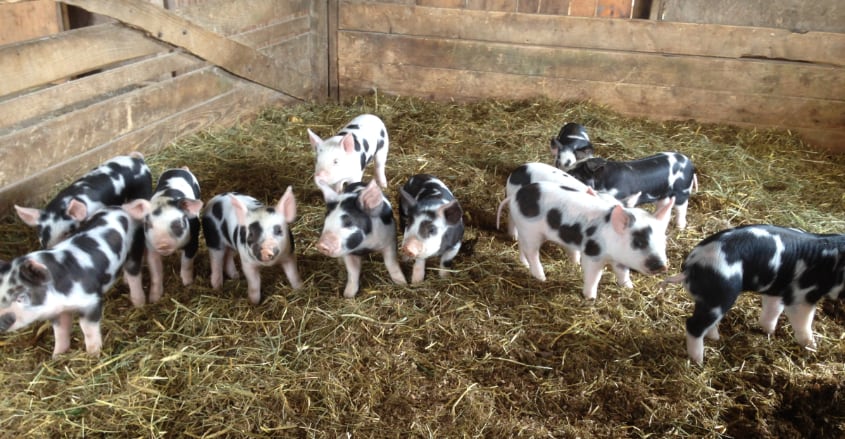
Type of Pig Operations
Most hog operations can be divided into two basic types: farrowing and feeder operations. A farrowing operation focuses on keeping and breeding sows to produce piglets, which are then sold after weaning to someone who will raise them to finish. The sow is rebred and another litter produced. Farrowing sows involves having the ability to breed the sows, which can be done either through AI (artificial insemination) or by natural service. If by natural service, it will be necessary to keep a boar, or have access to one. If by AI, having the training to do it yourself or an AI tech close by will be necessary. The customer of a farrowing operation is typically a feeder operation, which we describe below.
A feeder operation typically buys weaned piglets that are around 60-80 pounds and will raise them until they are processed. Feeder operations are a great fit for beginning farmers, as you can raise pigs seasonally and be all done in less than six months. The customer for a feeder operation is typically someone who will buy the pork, and a lot of feeder operations will directly market their pork to the end consumer.
There are some operations that are farrow-to-finish, meaning they breed and farrow their own sows and raise the piglets all the way until processing. This requires another layer of management and complexity, but also allows the farmer to have complete control over the whole life of the pigs and is able to know everything that has happened to them. This is especially important if you are in a situation where your customer or a certification requires transparency or tracking of the pigs life. Secondly, it also allows the farmer to better manage the genetics and select for pigs that perform well in their environment or production system.
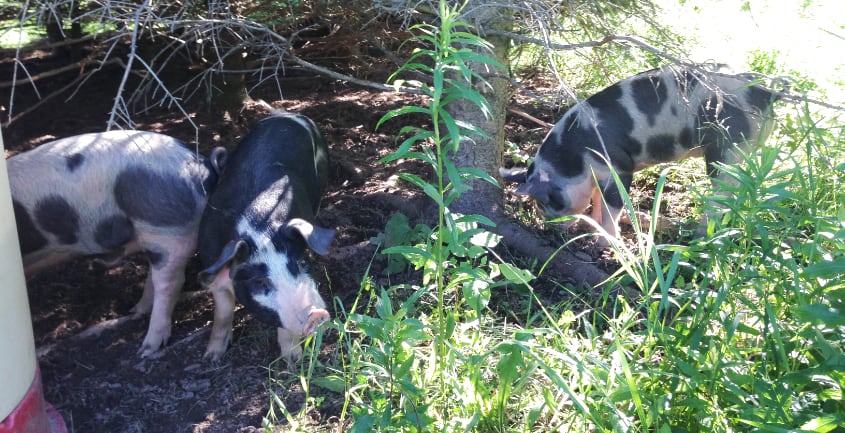
Breeds of Pigs
There are a lot of different breeds of pigs that can work well in a pastured pig operation. When starting out, it is important to note that there are two main types of pigs, lard hogs and meat/bacon hogs. Lard hogs (as the name implies), have a higher fat-to-meat ratio and are often grown for the high quality fat they produce. They tend to be shorter in body length and put on fat easier. Meat/bacon pigs are longer in body length and grow muscle better, making them more suited for typical pork production. Below are some examples of different breeds in the categories.
Lard Pig Breeds
Mangalitsa
Pot-bellied pigs
American Guinea hogs
Large Black
Meat/Bacon Pig Breeds
Tamworth
Berkshire
Yorkshire
Duroc
Hampshire
It is important to note that there can be as much variation in a breed as between breeds, so use these examples as a starting point. Also, take into consideration the age at time of harvest and how the pig is fed – these factors will also greatly influence how much fat is present in the hog.
When selecting breeding stock or feeder pigs, it is important to find a breeder who produces pigs in a model similar to the way you intend to produce your pigs.
It is also important to try to source piglets from as similar a climate to yours as possible. Adapting to a different environment can be very stressful to livestock and can take a while. The stock that you acquire from them will be more accustomed (used to foraging, possibly trained to electric fence) to your intended production model which gives you an advantage. It is more important to find pigs that are raised in a similar way to how you intend to raise them and a breeder that shares your production values than to find the perfect breed.
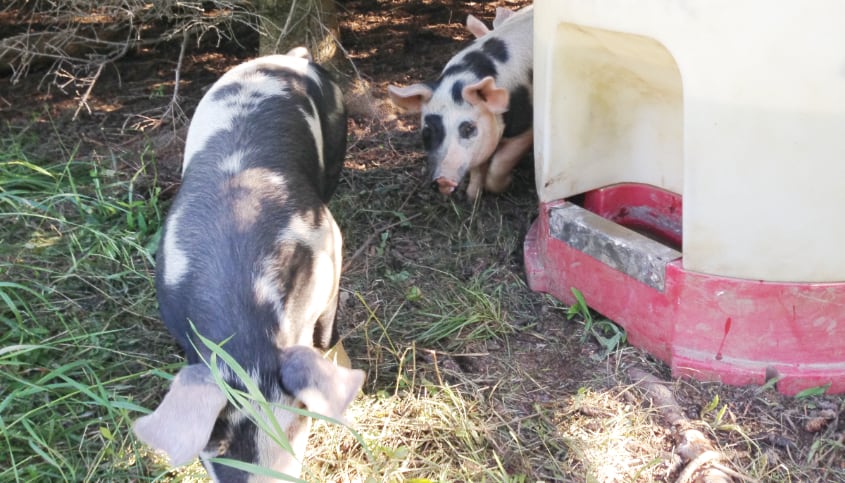
Land Management Ideas
Pigs have a strong instinct to root. They come with a “plow” on the front of their face and can be used to create intentional disturbance in the landscape. However, this rooting instinct must also be properly managed with stocking density and properly timed moves, otherwise you may end up with a site with a lot of bare soil that is prone to erosion, depending on the slope.
- A few days before you move pigs to a new paddock, try broadcasting some small grains such as oats or cereal rye (in spring or fall) or sorghum x sudan/millet (in the summer) throughout the paddock. The pigs may eat some of the seed, so overseed 10-20 percent extra and make sure the seed is untreated. The seed will get somewhat incorporated into the ground by the pigs trampling it in and will provide a cover crop that can be grazed by other livestock. This helps to get any bare ground covered as quickly as possible and increases diversity on the landscape. Alternately, after the pigs have moved, lightly till to smooth the ground and then seed.
- Pigs moved very quickly across pastures will create minimal damage and will consume a substantial amount of forage. Pigs under 150 pounds that are moved quickly don’t seem to root up pastures as much as pigs over 150 pounds.
- Use pigs to prepare sites for planting. Under the right soil conditions, stocking rate and timely paddock moves, pigs can help to break up sod, dig up rhizome roots, and disrupt pest cycles. This is particularly useful when planting root crops that typically require intensive soil disturbance, or as a tool to prepare a planting bed without the use of herbicides. Typically, some mechanical preparation has to follow the pigs. This method should be on an extended rotation of at least four years.
- Pigs can also be successfully used to turn and stir compost and deep bedding packs. When bedding down your livestock, add whole corn to your bedding every other time that you bed. After the livestock have been removed, 150 + pound pigs can be brought in and in the process of finding the corn buried in the bedding pack, will turn and stir the bedding. Done correctly, the corn will ferment slightly and turn into pig candy! This helps to accelerate the decomposition process of the manure and carbon and makes it a more usable compost for spreading later.
- Hogs are also terrific foragers, they have an amazing sense of smell and will dig for grubs and insects that are deep in the ground. In the fall, harness that ability under oak and other mast-tree producing areas to let the pigs self-harvest mast crops. Using a single strand of electric fence with larger, well-trained pigs, large areas of forest can be accessed. The pigs will be able to harvest a high percentage of their diet using this technique, depending on the amount of feed available, which will vary from year to year. When the pigs start consuming more and more supplemental feed, it’s a sign they have harvested most of the mast available and should move on to the next site. Avoid this practice during wet conditions to avoid soil compaction, or focus on sites with well-drained soils.
- Allowing hogs access to orchards to eat dropped fruit after the bulk of the harvest is complete is another great way to cut feed costs and utilize a resource that may otherwise go to waste. You will want to be careful if young trees are present as larger pigs will kill them. If this could be an issue, fence in these small trees, use smaller pigs, or focus on more mature orchards.
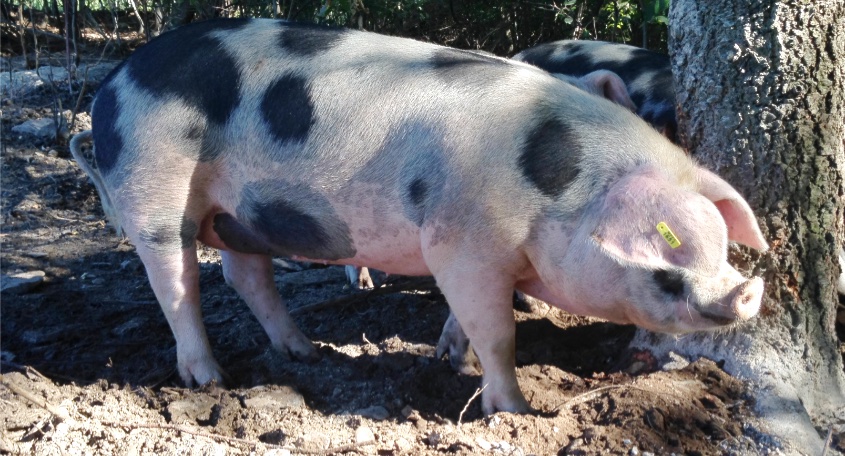
Soil Health Principles Integration
When applying the six soil health principles, pigs fit the principles of diversity and integrating livestock into your farm or ranch. Pigs can utilize waste grain, crop residue, hog down cover crops (consider planting covers for the pigs to self-harvest) and can be a great addition for landscape management and farm diversity.
However, care and management must be proper to ensure that the principle of limited disturbance of the soil is not violated. Like many agricultural enterprises, if not properly managed, swine can have a negative impact on the landscape and surrounding ecology.
Resources
- Farmbuilder Youtube Channel: A wealth of information on farrow-to-finish pig production on pasture.
- Pigs n’ Glens Polyface Primer Series: A documentary-style film on how to produce nutrient-dense pork on pasture and in the woods. This DVD focuses on feeder pig-finish production.
- Sugar Mountain Farm, Walter Jeffries
- Orchards for livestock
Equipment
Waterers
Excellent Field Waterer (Best for warmer weather, not ideal for providing winter water)
Nipple Waterer option: Install these into a 55-gallon barrel or 275-gallon IBC tote to build a simple, homemade pig waterer.
Feeders
Osborne Feeders: Manufacturers of high-capacity hog feeders for both indoor and outdoor production.
Brower Equipment: Provides feeders and waterers for both small- and large-scale producers.
Fencing
Premier 1 Fencing: They make a portable pig netting that is widely used and other fencing and livestock supplies.
American Grazinglands: General fencing supplies.
Kencove Fence Supply: Another general resource for fencing supplies.
Energizer Brands we recommend: Speedrite and Stafix (TruTest brands, sold by Premier 1 or American Grazinglands), Cyclops, and Gallagher are all reputable brands with great performance and support from the manufacturer.
Thanks to Dayna Burtness and Jim Chamberlin for reviewing and adding to this fact sheet.
